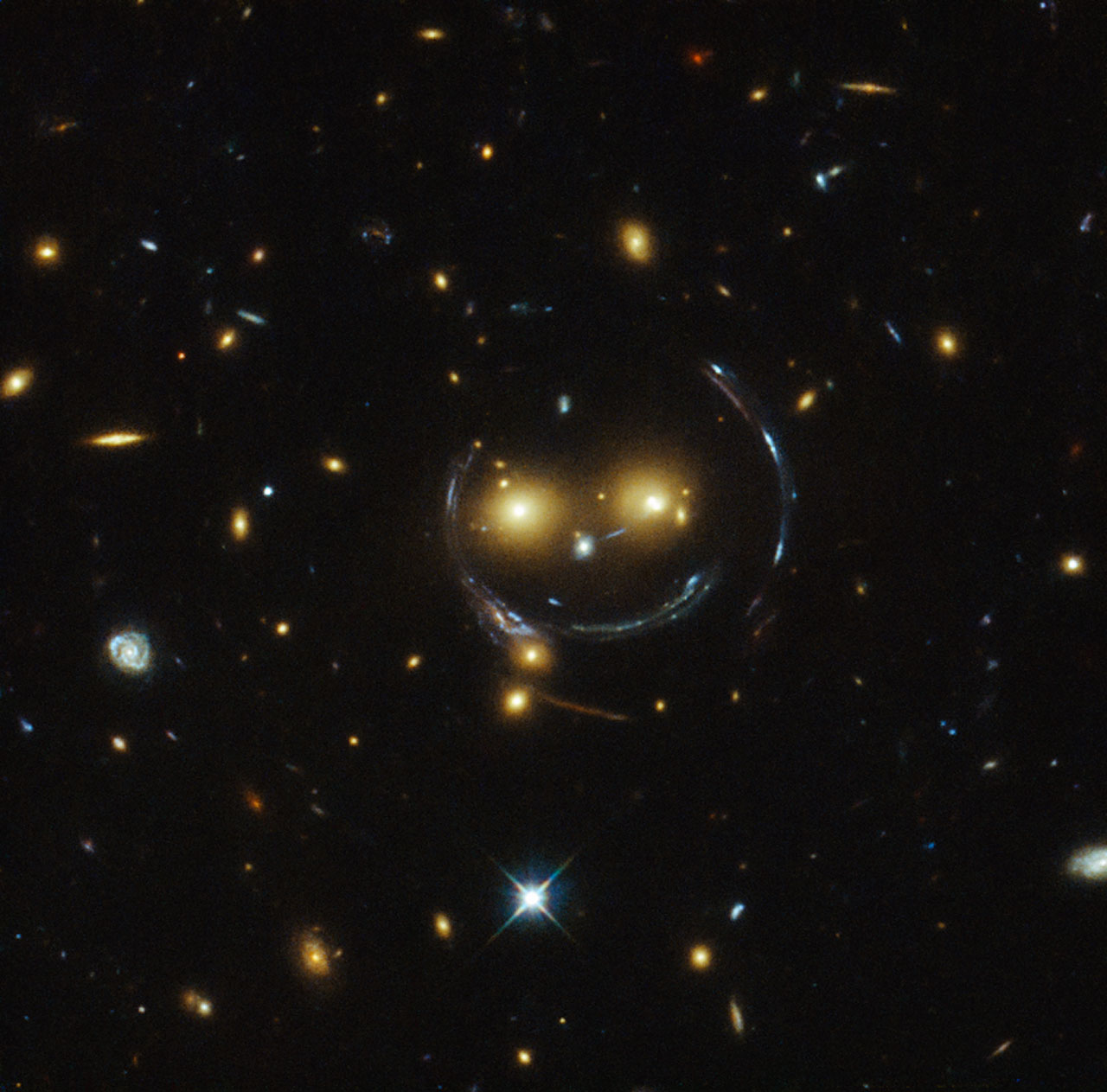It looks like you're using an Ad Blocker.
Please white-list or disable AboveTopSecret.com in your ad-blocking tool.
Thank you.
Some features of ATS will be disabled while you continue to use an ad-blocker.
7
share:

In the centre of this image, taken with the NASA/ESA Hubble Space Telescope, are two faint galaxies that seem to be smiling.
You can make out two orange eyes and a white button nose. In the case of this “happy face”, the two eyes are the galaxies SDSSCGB 8842.3 and SDSSCGB 8842.4 and the misleading smile lines are actually arcs caused by an effect known as strong gravitational lensing.
Massive structures in the Universe exert such a powerful gravitational pull that they can warp the spacetime around them and act as cosmic lenses which can magnify, distort and bend the light behind them. This phenomenon, crucial to many of Hubble’s discoveries, can be explained by Einstein’s theory of general relativity.
In this special case of gravitational lensing, a ring — known as an Einstein Ring — is produced from this bending of light, a consequence of the exact and symmetrical alignment of the source, lens and observer and resulting in the ring-like structure we see here.
Hubble-NASA-ESA continied
The above vs.....
a reply to: Granite
what do you think the massive structure is that is causing this lensing effect as they dont explain in article .could it be a massive ufo parked there because they know it would cause gravitational lensing and it is like the bat signal.
second thoughts dam that looks like a circular space station that has been chopped or maybe warped in processing .
what do you think the massive structure is that is causing this lensing effect as they dont explain in article .could it be a massive ufo parked there because they know it would cause gravitational lensing and it is like the bat signal.
second thoughts dam that looks like a circular space station that has been chopped or maybe warped in processing .
edit on 14-2-2015 by
stuthealien because: second thought
edit on 14-2-2015 by stuthealien because: (no reason given)
a reply to: stuthealien
We dont know if its a very large object closer to those galaxies or a smaller one much closer to us
Very cool effect though, i think i have a new "yo mammo so fat" joke evolving in my mind now hehehe
We dont know if its a very large object closer to those galaxies or a smaller one much closer to us
Very cool effect though, i think i have a new "yo mammo so fat" joke evolving in my mind now hehehe
originally posted by: stuthealien
what do you think the massive structure is that is causing this lensing effect as they dont explain in article .
A galaxy cluster containing the 'eyes.' The two eyes look, to me, like they're two massive galaxies.
I'm so pleased this has happened. It shows how humans are predisposed to making sense out of random pictures. This ads credence to the fact that the
face on mars is just a rock outcrop that when looked at from a distance resembles a face but as one gets closer, the resemblance goes away.
new topics
-
1 Billion dollars
General Entertainment: 11 minutes ago -
London Christmas Market BANS Word ‘Christmas’
Social Issues and Civil Unrest: 1 hours ago -
Marvin Gabrion's sentence commuted by Biden
US Political Madness: 2 hours ago -
Parker Solar Probe is about to Kiss the Sun
Space Exploration: 3 hours ago -
Drones On Live Beach Cam New Jersey.
Aliens and UFOs: 5 hours ago -
Christmas Dinner ??
Food and Cooking: 5 hours ago -
Merry Christmas !!
General Chit Chat: 8 hours ago
top topics
-
Merry Christmas !!
General Chit Chat: 8 hours ago, 13 flags -
Marvin Gabrion's sentence commuted by Biden
US Political Madness: 2 hours ago, 10 flags -
Christmas Dinner ??
Food and Cooking: 5 hours ago, 5 flags -
Drones On Live Beach Cam New Jersey.
Aliens and UFOs: 5 hours ago, 4 flags -
Parker Solar Probe is about to Kiss the Sun
Space Exploration: 3 hours ago, 4 flags -
London Christmas Market BANS Word ‘Christmas’
Social Issues and Civil Unrest: 1 hours ago, 4 flags -
1 Billion dollars
General Entertainment: 11 minutes ago, 0 flags
active topics
-
‘Something horrible’: Somerset pit reveals bronze age cannibalism
Ancient & Lost Civilizations • 21 • : BrucellaOrchitis -
London Christmas Market BANS Word ‘Christmas’
Social Issues and Civil Unrest • 20 • : TzarChasm -
Parker Solar Probe is about to Kiss the Sun
Space Exploration • 6 • : AdultMaleHumanUK -
1 Billion dollars
General Entertainment • 0 • : Blueracer -
President-elect TRUMP Picks MATT GAETZ for his ATTORNEY GENERAL - High Level PANIC Ensues.
2024 Elections • 143 • : WeMustCare -
Marvin Gabrion's sentence commuted by Biden
US Political Madness • 4 • : DBCowboy -
Christmas Dinner ??
Food and Cooking • 4 • : Naftalin -
Petition Calling for General Election at 564,016 and rising Fast
Political Issues • 164 • : gortex -
Well, here we go red lines crossed Biden gives the go ahead to use long range missiles
World War Three • 407 • : WeMustCare -
University looking for gender diverse kids to play with transgender dolls for research
Social Issues and Civil Unrest • 26 • : Myhandle
7
